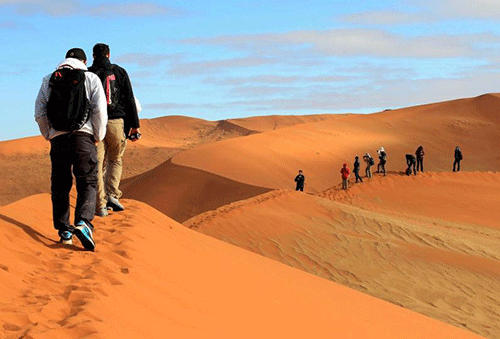Although domestic arrival data for 2023 is still being analysed by the environment, forestry and tourism ministry, all indications point to a massive increase in tourist arrivals this year, which has seen the revival of this crucial economic sector. In fact, the tourism sector is recovering at such a rate that local analysts anticipate that September figures could actually surpass pre-pandemic levels as a positive development for local tour operators and hospitality establishments.
“The ministry is happy to observe that the sector is regaining momentum after the devastating impact of Covid-19. We continue to observe a massive influx of tourists to the country, to the point that most accommodation establishments are full,” rejoiced the tourism ministry’s spokesperson, Romeo Muyunda.
The ministry recently released a tourists’ statistical report for 2022, which indicated a 98.1% increase in tourist arrivals from around 232 700 in 2021 to over 461 000 in 2022.
Responding to New Era’s queries on how the revival of the sector impacts locals, Muyunda stated: “This creates opportunities for those aspiring to get into the hospitality industry to do so. The increase in tourism arrivals is also welcome to assist the sector in recovering the losses incurred during the pandemic. This also presents a positive outlook for employment-creation in the sector, and significantly contributes to the GDP of the country. Tourism has always contributed to poverty reduction in the country through its multiplier effect”.
Meanwhile, a domestic hospitality report by local stock brokerage Simonis Storm (SS) observed that “given that September typically represents the peak month of the year, we anticipate that this September will surpass pre-pandemic levels”.
Moreover, the SS outlook and recovering trajectory for the local tourism sector remains optimistic.
In its report, SS noted that according to the European Travel Commission (ETC), Europeans’ intent to travel has decreased by 4% in comparison to previous years. This is as Austrians, Swiss and Germans exhibit increased hesitancy as holidaymakers, while the French, Belgians and British display greater enthusiasm for travel in the upcoming months of October and November. The decline in travel intent is ascribed to mounting financial pressures experienced by Europeans, coupled with concerns regarding elevated travel expenditures.
SS cautioned that this reluctance to travel might make a small dent in Namibian tourism figures, given that Austrians, Swiss and Germans account for 34% of the country’s tourists for the year-to-date.
“Namibia sustains its attractiveness as a destination, owing to the depreciation of the Rand, which has depreciated by 14.2% year-on-year against the Euro at the time of this analysis. In parallel, while the tourism industry remains actively engaged in diverse promotional campaigns spanning Europe, the USA and the regional arena, it is proactively shaping strategic collaborations with stakeholders and law-enforcement authorities” the report reads.
SS emphasised that this approach aims to address a recent surge in criminal incidents targeting tourists, necessitating a unified and concerted endeavour encompassing all facets of Namibian society.
“The tourism industry’s peak season has rebounded to pre-pandemic levels, with an August 2023 occupancy rate of 68.9%, up from 60.98% in July 2023.
This marks a notable 7.6 percentage point increase from the 61.3% rate recorded in August 2022. It stands as the highest occupancy rate since the last pre-pandemic peak of 69.9%,” the SS report continued.
The stock brokerage further pointed out that Namibia recently gained attention as Africa’s emerging millionaire hub, according to New World Health, attributable to the country’s favourable fiscal environment, characterised by low tax rates and a well-established banking system.
“Considering this positive international perception of Namibia, the tourism sector stands to reap the benefits. As Namibia becomes increasingly appealing to affluent individuals, it is poised to naturally draw a larger number of tourists,” SS stated.
SS further noted that for the year-to-date, Namibia’s average occupancy rate stood at 49.1%, 2.1 percentage points below the 2019 average of 51.2%.
“Nonetheless, this performance underscores the ongoing and much-needed recovery of the tourism sector. This positively contributes to GDP, as increased tourist activity translates into higher consumer spending in the country, providing vital support to accommodation and tour operator businesses,” SS added.
The tourism breakdown further shows that the majority of tourists, 51.7%, preferred a lodge experience in Namibia. SS attributed an upswing in hotel occupancy rates in the central area to tourists using these facilities as a resting point before embarking, mainly on self-driven journeys, to lodges located in the northern and southern regions, or before departing the country to their next destination.
For the year-to-date, Europeans made up a significant portion of Namibia’s tourist demographic, accounting for 56.5%, a share similar to their representation in 2019, which stood at 49.8%.
Concurrently, Namibians constitute a smaller portion of the tourist pool at 23.7%, in contrast to their 65.1% share in 2020. This shift, SS stated, is attributable to the increased number of tourists entering the country, reducing the proportional representation of Namibian tourists. In August 2023, the tourist composition consisted of 72.3% Europeans, 14.2% Namibians, 4.3% South Africans, and 2.2% Asians.


